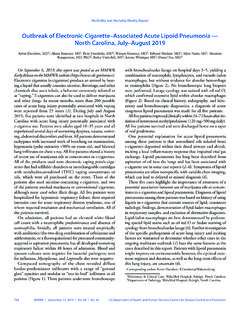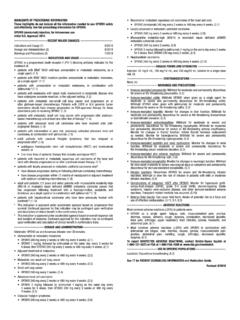Transcription of Nephrotic Syndrome in Adults: Diagnosis and Management
1 Nephrotic Syndrome in Adults: Diagnosis and Management CHARLES KODNER, MD, University of Louisville School of Medicine, Louisville, Kentucky Nephrotic Syndrome may be caused by primary (idiopathic) renal disease or by a variety of secondary causes. Patients present with marked edema, proteinuria, hypoalbuminemia, and often hyperlipidemia. In adults, diabetes mellitus is the most common secondary cause, and focal segmental glomerulosclerosis and membranous nephropathy are the most common pri- mary causes. Venous thromboembolism is a possible complication; acute renal failure and serious bacterial infection are also possible, but much less common. There are no established guidelines on the diagnostic workup or Management of Nephrotic Syndrome . Imaging stud- ies are generally not needed, and blood tests should be used selectively to diagnose specific disorders rather than for a broad or unguided workup. Renal biopsy may be useful in some cases to confirm an underlying disease or to identify idiopathic disease that is more likely to respond to corticosteroids.
2 Treatment of most patients should include fluid and sodium restric- tion, oral or intravenous diuretics, and angiotensin-converting enzyme inhibitors. Some adults with Nephrotic Syndrome may benefit from corticosteroid treatment, although research data are limited. Intravenous albumin, prophylactic antibiotics, and prophylactic anticoagulation are not currently recommended. (Am Fam Physician. 2009;80(10):1129-1134, 1136. Copyright 2009 American Academy of Family Physicians.). I. Patient information: n Nephrotic Syndrome , a variety of dis- idiopathic Nephrotic Other . A handout on Nephrotic orders cause proteinuria, often resulting conditions, such as membranoprolifera- Syndrome , written by the in marked edema and hypoalbumin- tive glomerulonephritis, are less common. author of this article, is provided on page 1136. emia. Hyperlipidemia is a common FSGS accounts for approximately per- associated finding. Family physicians may cent of new cases of end-stage renal dis- encounter persons with Nephrotic Syndrome A large number of secondary causes This clinical content con- from primary (idiopathic) renal disease or of Nephrotic Syndrome have been identified forms to AAFP criteria for a number of secondary causes, and should (Table 2),3 with diabetes mellitus being the evidence-based continu- ing medical education initiate appropriate diagnostic workup and most common.
3 (EB CME). medical Management pending specialist consultation. Pathophysiology The underlying pathophysiology of Nephrotic Causes Syndrome is not completely Although Most cases of Nephrotic Syndrome appear to the more intuitive underfill mechanism of be caused by primary kidney disease. Table 1 edema from reduced oncotic pressure caused summarizes the recognized histologic pat- by marked proteinuria may be the primary terns and features of primary Nephrotic mechanism in children with acute Nephrotic Membranous nephropathy and Syndrome , edema in adults may be caused by focal segmental glomerulosclerosis (FSGS) a more complex mechanism. Massive protein- each account for about one third of cases uria causes renal tubulointerstitial inflam- of primary Nephrotic Syndrome ; however, mation, with resulting increased sodium FSGS is the most common cause of idio- retention that overwhelms the physiologic pathic Nephrotic Syndrome in Mini- mechanisms for removing Patients mal change disease and (less commonly) may have an overfilled or expanded plasma immunoglobulin A (IgA) nephropathy volume in addition to expanded intersti- cause approximately 25 percent of cases of tial fluid volume.
4 This may be clinically . Downloaded from the American Family Physician Web site at Copyright 2009 American Academy of Family Physicians. For the private, noncommercial use of one individual user of the Web site. All other rights reserved. Contact for copyright questions and/or permission requests. SORT: KEY RECOMMENDATIONS FOR PRACTICE. Evidence Clinical recommendation rating References Random urine protein/creatinine ratio should be used to assess the C 6. degree of proteinuria in persons with Nephrotic Syndrome . Renal biopsy may be helpful to guide Diagnosis and treatment, but is not C 13. indicated in all persons with Nephrotic Syndrome . Sodium and fluid restriction and high-dose diuretic treatment are C 3, 14. indicated for most persons with Nephrotic Syndrome . Angiotensin-converting enzyme inhibitor treatment is indicated for most C 16. persons with Nephrotic Syndrome . Corticosteroid treatment has no proven benefit, but is recommended C 19, 20.
5 By some physicians for persons with Nephrotic Syndrome who are not responsive to conservative treatment. A = consistent, good-quality patient-oriented evidence; B = inconsistent or limited-quality patient-oriented evi- dence; C = consensus, disease-oriented evidence, usual practice, expert opinion, or case series. For information about the SORT evidence rating system, go to important if over-rapid diuresis leads to acute have Nephrotic Syndrome . Although a renal failure from reduced glomerular blood urine dipstick proteinuria value of 3+ is a flow, despite persistent edema. useful semiquantitative means of identify- ing Nephrotic -range proteinuria, given the Clinical Features logistic difficulties of collecting a 24-hour Progressive lower extremity edema, weight urine sample, the random urine protein/. gain, and fatigue are typical presenting symp- creatinine ratio is a more convenient quan- toms of Nephrotic Syndrome . In advanced titative measure.
6 The numeric spot urine disease, patients may develop periorbital or protein/creatinine ratio, in mg/mg, accu- genital edema, ascites, or pleural or pericardial rately estimates protein excretion in g per effusion. Persons who present with new edema day per m2 of body surface area, so a or ascites, without typical dyspnea of conges- ratio of 3 to represents Nephrotic -range tive heart failure or stigmata of cirrhosis, Low serum albumin levels should be assessed for Nephrotic Syndrome . (less than g per dL [25 g per L]) and Nephrotic -range proteinuria is typically severe hyperlipidemia are also typical fea- defined as greater than 3 to g of protein tures of Nephrotic Syndrome . In one study in a 24-hour urine collection; however, not of persons with Nephrotic Syndrome , 53 per- all persons with this range of proteinuria cent had a total cholesterol level greater than Table 1. Histologic Patterns and Features of Primary Nephrotic Syndrome Histologic pattern Key pathologic features Key clinical features Focal segmental Sclerosis and hyalinosis of segments of May be associated with hypertension, renal insufficiency, glomerulosclerosis less than 50 percent of all glomeruli on and hematuria electron microscopy Membranous Thickening of the glomerular basement Peak incidence at 30 to 50 years of age; may have nephropathy membrane on electron microscopy; microscopic hematuria; approximately 25 percent of immunoglobulin G and C3 deposits patients have underlying systemic disease, such as systemic with immunofluorescent staining lupus erythematosus, hepatitis B, or malignancy, or drug- induced Nephrotic Syndrome Minimal change Normal-appearing glomeruli on renal Relatively mild or benign cases of Nephrotic Syndrome ; may disease biopsy microscopy.
7 Effacement of foot occur following upper respiratory infection or immunization processes on electron microscopy Information from reference 1. 1130 American Family Physician Volume 80, Number 10 November 15, 2009. Nephrotic Syndrome 300 mg per dL ( mmol per L) and 25 per- therapeutic drug complications, sepsis, renal cent had a total cholesterol level greater than venous thrombosis, renal interstitial edema, 400 mg per dL ( mmol per L).7 and marked hypotension may cause or con- Possible complications of Nephrotic syn- tribute to acute renal drome include venous thromboembolism caused by loss of clotting factors in the urine, Diagnostic Evaluation infection caused by urinary loss of immuno- Typical clinical and laboratory features of globulins, and acute renal failure. Throm- Nephrotic Syndrome are sufficient to estab- boembolism has long been recognized as a lish the Diagnosis of Nephrotic Syndrome . complication of Nephrotic In a The diagnostic evaluation focuses on iden- large retrospective review, the relative risk of tification of an underlying cause and on the deep venous thrombosis (DVT) in patients role of renal biopsy.
8 However, there are no with Nephrotic Syndrome was compared published practice guidelines available about with those without Nephrotic Syndrome , the diagnostic evaluation of persons with with an annual incidence of DVT of per- Nephrotic cent9 ; the risk seems highest in the first six Initial investigation should include history, months after The relative risk of physical examination, and a serum chemistry pulmonary embolism was and was espe- panel. Given the large number of potential cially high in persons 18 to 39 years of age causes of Nephrotic Syndrome and the rela- (relative risk = ). Renal venous throm- tively nonspecific aspect of therapy, the diag- bosis is a possible complication of Nephrotic nostic evaluation should be guided by clinical Syndrome , but was uncommon in this case suspicion for specific disorders, rather than series. Membranous nephropathy and serum a broad or unguided approach to ruling out albumin levels less than to g per dL multiple illnesses.
9 Table 3 lists selected diag- (20 to 25 g per L) seem to confer an increased nostic studies for some common secondary risk of DVT. Arterial thrombotic complica- tions can occur, but are Infection is also a possible complication Table 2. Common Secondary Causes of Nephrotic Syndrome of Nephrotic Syndrome ; however, this risk appears primarily in children and in persons Cause Key features who have relapses of Nephrotic Syndrome or Diabetes mellitus Glucosuria, hyperglycemia, polyuria who require longer-term corticosteroid ther- Systemic lupus Anemia, arthralgias, autoantibodies, photosensitivity, Invasive bacterial infections, especially erythematosus pericardial or pleural effusion, rash cellulitis, peritonitis, and sepsis, are the most Hepatitis B or C Elevated transaminases; high-risk sexual activity, common infections attributable to Nephrotic history of transfusion, intravenous drug use, or Syndrome . The mechanisms of infection other risk factors for disease transmission are unclear, but may relate to the degree of Nonsteroidal anti- Causes minimal change disease edema, loss of serum IgG with overall pro- inflammatory drugs teinuria,1 effects of corticosteroid therapy, Amyloidosis Cardiomyopathy, hepatomegaly, peripheral reduced complement or T cell function, or neuropathy impaired phagocytic The risk of Multiple myeloma Abnormal urine protein electrophoresis, back pain, renal insufficiency serious bacterial infection attributable to HIV Pathologically similar to focal segmental Nephrotic Syndrome in adults in the United glomerulosclerosis; risk factors for HIV.
10 States is unclear, but seems low. transmission, possible reduced CD4 cell count Acute renal failure is a rare, spontane- Preeclampsia Edema and proteinuria during pregnancy; elevated ous complication of Nephrotic Syndrome . blood pressure Although older persons, children, and those with more profound edema and proteinuria NOTE: Causes are in approximate order of most to least common. are at highest risk, there are many possible HIV = human immunodeficiency virus. causes or contributing factors to acute renal Information from reference 3. failure in this setting. Excessive diuresis, November 15, 2009 Volume 80, Number 10 American Family Physician 1131. Nephrotic Syndrome Table 3. Diagnostic Evaluation in Persons with Nephrotic Syndrome Diagnostic studies Disorder suggested likelihood that Nephrotic Syndrome will Baseline respond to corticosteroid treatment, there Patient history Identify medication or toxin exposure;. risk factors for HIV or viral hepatitis; and are no biopsy findings that accurately pre- symptoms suggesting other causes of edema dict corticosteroid responsiveness.












